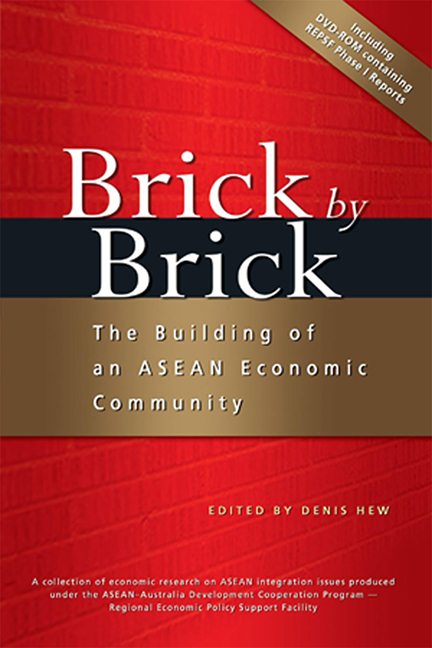Book contents
- Frontmatter
- Contents
- Foreword by Ong Keng Yong
- Foreword by Bruce Davis
- Acknowledgements by Academic Editor
- Acknowledgements by Technical Director REPSF
- The Contributors
- The Regional Economic Policy Support Facility
- 1 Introduction: Brick by Brick — The Building of an ASEAN Economic Community
- 2 What is a Single Market? An Application to the Case of ASEAN
- 3 The Challenge of Economic Integration for Transitional Economies of Southeast Asia
- 4 A Review of Regional Tariffs and Trade in the ASEAN Priority Goods Sectors
- 5 Non-tariff Barriers to Trade in the ASEAN Priority Goods Sectors
- 6 An Assessment of ASEAN's Priority Sectors for Fast-track Integration
- 7 ASEAN Tax Regimes: Impediment or Pathway to Greater Integration
- 8 An Overview of the Foreign Direct Investment Jurisprudence
- 9 ASEAN's FTA Negotiations with Dialogue Partners:Identifying Strengths and Weaknesses in Business Opportunities
- 10 Conclusion: Towards an ASEAN Economic Community by 2015
- Index
- Contents of Accompanying CD-ROM: AADCP-REPSF Phase I Research Program
3 - The Challenge of Economic Integration for Transitional Economies of Southeast Asia
Published online by Cambridge University Press: 21 October 2015
- Frontmatter
- Contents
- Foreword by Ong Keng Yong
- Foreword by Bruce Davis
- Acknowledgements by Academic Editor
- Acknowledgements by Technical Director REPSF
- The Contributors
- The Regional Economic Policy Support Facility
- 1 Introduction: Brick by Brick — The Building of an ASEAN Economic Community
- 2 What is a Single Market? An Application to the Case of ASEAN
- 3 The Challenge of Economic Integration for Transitional Economies of Southeast Asia
- 4 A Review of Regional Tariffs and Trade in the ASEAN Priority Goods Sectors
- 5 Non-tariff Barriers to Trade in the ASEAN Priority Goods Sectors
- 6 An Assessment of ASEAN's Priority Sectors for Fast-track Integration
- 7 ASEAN Tax Regimes: Impediment or Pathway to Greater Integration
- 8 An Overview of the Foreign Direct Investment Jurisprudence
- 9 ASEAN's FTA Negotiations with Dialogue Partners:Identifying Strengths and Weaknesses in Business Opportunities
- 10 Conclusion: Towards an ASEAN Economic Community by 2015
- Index
- Contents of Accompanying CD-ROM: AADCP-REPSF Phase I Research Program
Summary
Introduction
One of the difficult challenges facing Cambodia, Lao PDR, Myanmar, and Vietnam (usually referred to as CLMV) as new members of ASEAN is how to implement their commitments and obligations as signatories of the ASEAN Free Trade Area (AFTA). There is a real concern that, as they reduce their tariffs in accordance with the AFTA guidelines, they will suffer significant revenue losses with adverse economic and social implications. Revenues from import tariffs in these countries constitute a sizeable proportion of their government revenues (for example, the share of import tariffs in total revenue among CLMV countries has ranged between 7 per cent and 25 per cent).
In light of this concern, this study aims to investigate if there is any empirical basis of this concern and to draw out some policy implications. Except for the studies made by Fukase and Martin (1999a–d) for the World Bank and by Lao-Araya (2002), no in-depth study has yet been undertaken to assess the tariff revenue implications as a result of their participation in AFTA. Fukase and Martin (1999a–d) used a static computable general equilibrium model (CGE) based on a full market equilibrium assumption. Lao-Araya (2002) used a partial equilibrium approach but her estimates due to the lack of disaggregated data were highly aggregative and did not take into account the growth of imports. This paper uses a partial equilibrium approach and takes into account the growth of imports. Its estimates are also derived from disaggregated data which have become available.
The rest of the paper is organized as follows: section 2 provides a brief review of the major aspects of AFTA and the trade liberalization commitments made by CLMV countries as new members of ASEAN; section 3 discusses the revenue structure in CLMV countries; section 4 briefly presents the theoretical basis and the methodology used for this study; section 5 discusses the revenue impact; section 6 suggests a set of policy recommendations followed by some concluding remarks in section 7.
- Type
- Chapter
- Information
- Brick by BrickThe Building of an ASEAN Economic Community, pp. 36 - 58Publisher: ISEAS–Yusof Ishak InstitutePrint publication year: 2007



